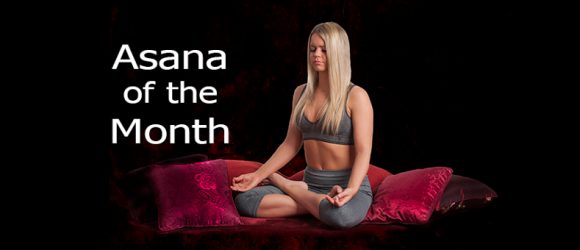Lotus (Padmasana)
- At March 16, 2020
- By Daniel
- In Asana, Yoga Benefits
 0
0
 No other pose is more closely associated with hatha yoga than Lotus pose (padmasana). Lotus is what hatha yoga is all about. Asana prepares the body to sit in Lotus for hours of meditation. Many Westerners associate asana with a physical workout to tone the body. Astanga and power yoga are just another way of working up a sweat and staying in shape. Its nothing more than a work-out for the body.
No other pose is more closely associated with hatha yoga than Lotus pose (padmasana). Lotus is what hatha yoga is all about. Asana prepares the body to sit in Lotus for hours of meditation. Many Westerners associate asana with a physical workout to tone the body. Astanga and power yoga are just another way of working up a sweat and staying in shape. Its nothing more than a work-out for the body.
Yoga is not about obtaining firm abs. It is about obtaining a higher consciousness on the road to enlightenment (samadhi)- the eight limb of yoga.
Lotus can be too extreme for people with limited flexibility. Men usually find it more difficult to sit in Lotus than women. With practice, most men and women can can increase their flexibility and sit in Lotus pose. But, if it doesn’t happen do not dwell on it. You are not alone. The best I’ve ever achieved was half Lotus.
English Name: Lotus
Sanskrit Name: Padmasana
Difficulty Level: 3
Start Position: Staff
Instructions:
Step 1.
Bend your right knee, rotating from the hip, and place your right foot on your left thigh as close to your abdomen as possible.
Step 2.
Rotate your left hip and bend your left leg placing your left foot on your right thigh as close to your abdomen as possible.
Step 3.
Both knees should contact the floor. Remain in the pose as long as it feels comfortable.
Physical Benefits:
- Opens up the hips
- Improves knee flexibility
- Lubricates knee joint
- Relieve or prevent arthritis
- Tones abdominal muscles
- Improves digestion
- Tones back and shoulder muscles
Mental Benefits
- Focuses the mind
- Reduces stress
- Reduces anxiety
- Reduces mild depression
Contraindications:
- Low back, hip, knee, or ankle injury
Gentle Variation – Half Lotus

Standing Wide Leg Forward Bend II (Prasarita Padottanasana II)
- At March 14, 2020
- By Daniel
- In Asana, Yoga Benefits
 0
0
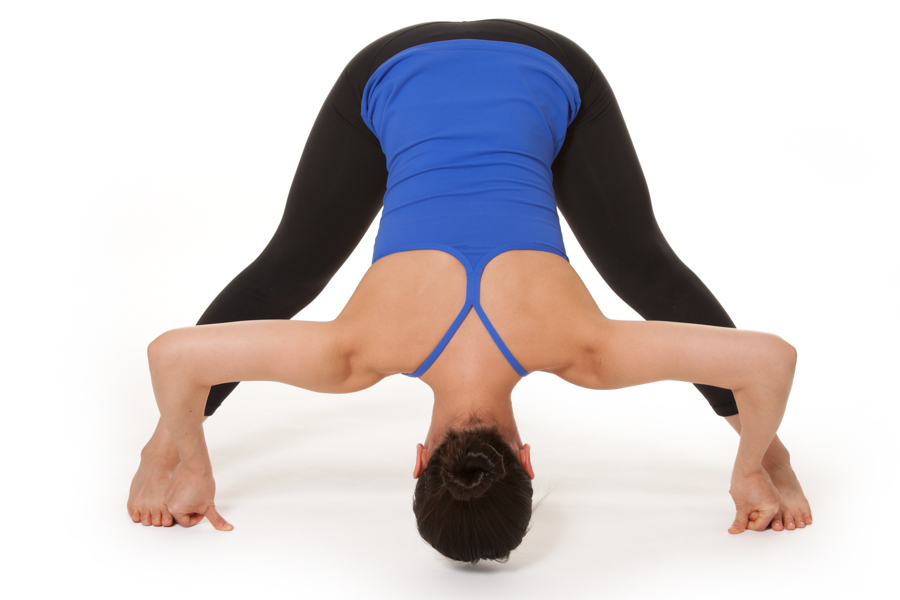 All Standing Forward Bends improves and maintains leg and back flexibility. For some people, wide leg forward bends put less stress on their backs and legs than straight leg forward bends. All forward bends provide the same physical and mental health benefits.
All Standing Forward Bends improves and maintains leg and back flexibility. For some people, wide leg forward bends put less stress on their backs and legs than straight leg forward bends. All forward bends provide the same physical and mental health benefits.
Use caution if you have glaucoma or a family history of high blood pressure. A research study found yoga poses where the head is lower than the heart may increase eye pressure. One way to reduce the risk is by limiting your time in these poses.
English Name: Standing Wide Leg Forward Bend II
Sanskrit Name: Prasarita Padottanasana II
Difficulty Level: 4
Start Position: Mountain
Instructions:
Step 1.
Step or jump your feet about 3 feet apart or a comfortable distance keeping your feet parallel to each other.
Step 2.
Bend (fold) forward from your hips maintaining a straight back and tilting your sit bones upward.
Step 3.
Curl the first two fingers on each hand around your big toes. If possible, rest the crown of your head on the floor.
Step 4.
Remain in the pose as long as it feels comfortable. Return to Mountain pose.
Physical Benefits:
- Improves and maintains ankle, knee, thigh and low back strength
- Tones abdomen
- Stretches wrists, arms, hamstrings, calves
- Reduces minor back pain or discomfort
- Lowers blood pressure
- Reduce headache pain
- Open sinuses
- Improves digestions
Mental Benefits
- Reduces stress
- Improves thinking
- Increases focus
- Relieves mild anxiety & depression
Contraindications:
- Low back or wrist injury
- High Blood Pressure
- Glaucoma
Standing Wide Leg Forward Bend I (Prasarita Padottanasana I)
- At March 12, 2020
- By Daniel
- In Asana, Yoga Benefits
 0
0
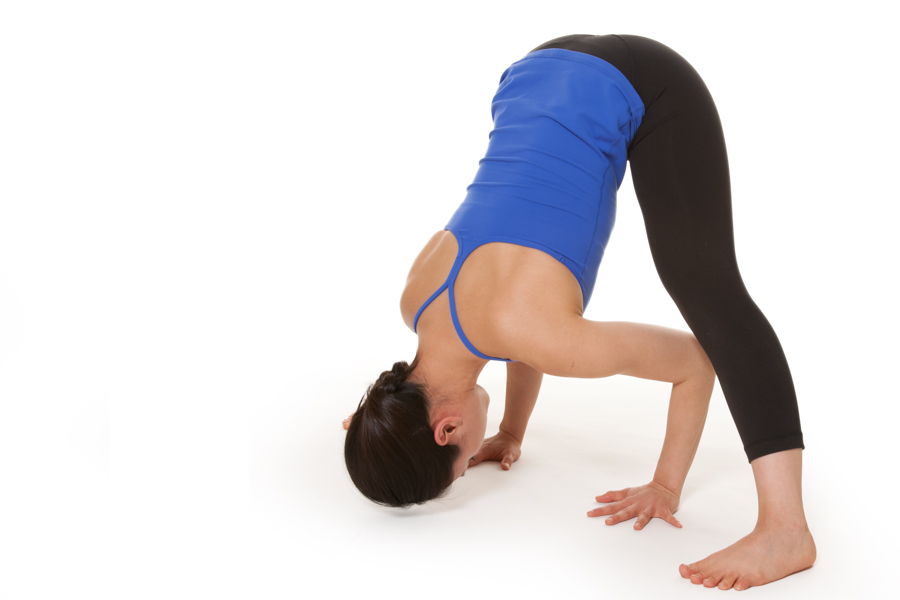 Standing Forward Bends improves and maintains leg and back flexibility. Use caution if you have glaucoma or a family history of high blood pressure. A research study found yoga poses where the head is lower than the heart may increase eye pressure. One way to reduce the risk is by limiting your time in these poses.
Standing Forward Bends improves and maintains leg and back flexibility. Use caution if you have glaucoma or a family history of high blood pressure. A research study found yoga poses where the head is lower than the heart may increase eye pressure. One way to reduce the risk is by limiting your time in these poses.
English Name: Standing Wide Leg Forward Bend I
Sanskrit Name: Prasarita Padottanasana I
Difficulty Level: 4
Start Position: Mountain
Instructions:
Step 1.
Step or jump your feet about 3 feet apart or a comfortable distance.
Step 2.
Bend (fold) forward from your hips maintaining a straight back and tilting your sit bones upward.
Step 3.
Place both hands on the floor energizing your hands and fingers, and keeping your hands parallel with your feet.
Step 4. Rest the crown of your head on the floor, and remain in the pose as long as it feels comfortable. Return to Mountain pose.
Physical Benefits:
- Improves and maintains ankle, knee, thigh and low back strength
- Tones abdomen
- Stretches wrists, arms, hamstrings, calves
- Reduces minor back pain or discomfort
- Lowers blood pressure
- Reduce headache pain
- Open sinuses
- Improves digestions
Mental Benefits
- Reduces stress
- Improves thinking
- Increases focus
- Relieves mild anxiety & depression
Contraindications:
- Low back or wrist injury
- High Blood Pressure
- Glaucoma
Half Cobra (Ardha Bhujangasana)
- At March 10, 2020
- By Daniel
- In Asana, Yoga Benefits
 0
0
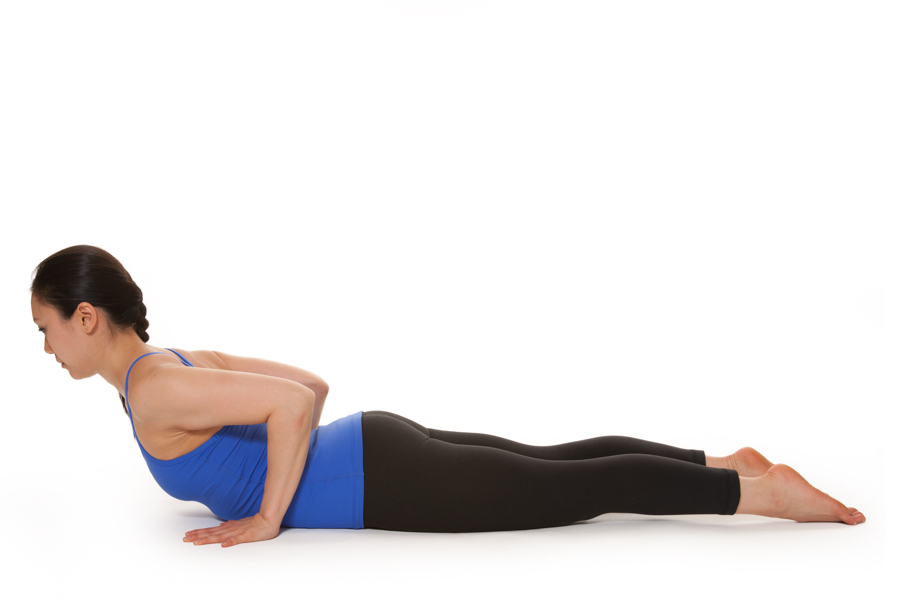 Half Cobra has the same physical and mental benefits of Cobra Pose. If you are new to yoga and have limited flexibility, you can do Half Cobra instead of Cobra pose in Sun Salutations and other yoga routines until you develop flexibility to do full Cobra pose.
Half Cobra has the same physical and mental benefits of Cobra Pose. If you are new to yoga and have limited flexibility, you can do Half Cobra instead of Cobra pose in Sun Salutations and other yoga routines until you develop flexibility to do full Cobra pose.
English Name: Half Cobra
Sanskrit Name: Bhujangasana
Difficulty Level: 4
Start Position: Lying on belly
Instructions:
Step 1.
Position your hands alongside your ribs.
Step 2.
Inhale, slinging your chest forward and slightly up, keeping your belly on the floor.
Step 3.
Extend through the crown of your head and keep your shoulders drawn back. Gaze at the floor.
Step 4.
Hold for several breaths, or as long as is comfortable, and exhale back to start position. Repeat if desired.
Physical Benefits:
- Improves circulation
- Improves posture
- Improves digestion
- Opens the chest and shoulders
- Lengthens the spine
- Increased spinal flexibility
- Strengthens lower back
- Strengthens shoulders
Mental Benefits
- Reduces stress
- Improves focus
- Reduces mild depression
- Reduces anxiety
Contraindications:
- Pregnancy
- High blood pressure
- Severe spinal injury
- Severe neck injury
Mountain Pose (Tadasana)
- At March 10, 2020
- By Daniel
- In Asana, Yoga Benefits
 0
0
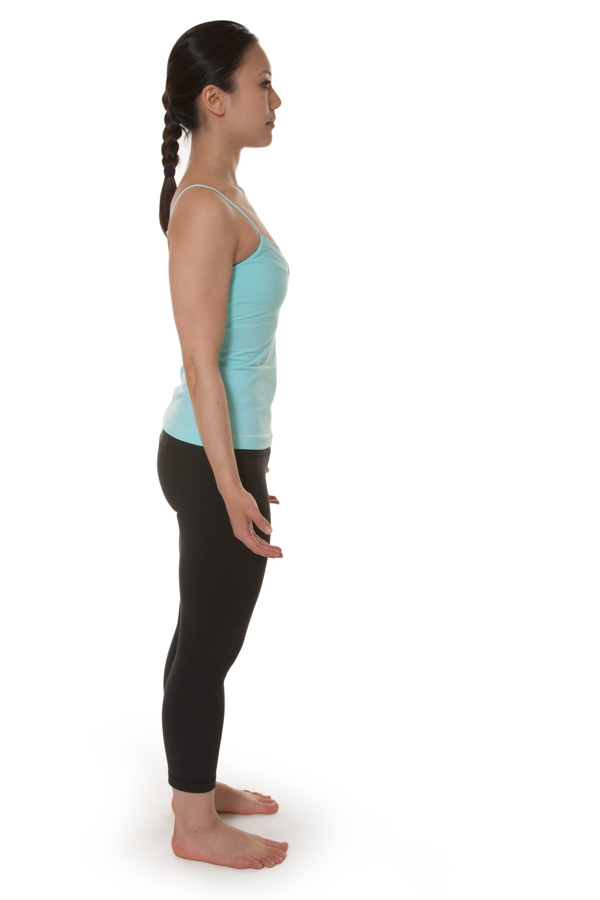 Mountain Pose is the start position for many standing poses and salutations like the Sun Salutation. Like Staff pose, it looks Mountain pose is a simple, straight forward pose. Mountain pose is about balance and focus. Place more weight on leg verses the other and you can loose your balance and topple over. The legs and spine are straight. The knees should not be bent. The arms are straight, not bent at the elbow or wrist. The head and neck are straight, not tilted to one side or front to back. While Mountain pose has a difficulty level of 1 out of 10, there is more to the pose than meets the eye.
Mountain Pose is the start position for many standing poses and salutations like the Sun Salutation. Like Staff pose, it looks Mountain pose is a simple, straight forward pose. Mountain pose is about balance and focus. Place more weight on leg verses the other and you can loose your balance and topple over. The legs and spine are straight. The knees should not be bent. The arms are straight, not bent at the elbow or wrist. The head and neck are straight, not tilted to one side or front to back. While Mountain pose has a difficulty level of 1 out of 10, there is more to the pose than meets the eye.
English Name: Mountain
Sanskrit Name: Tadasana
Difficulty Level: 1
Start Position: Standing Erect
Instructions:
Step 1. Stand with feet hip-width apart. Relax your shoulders and relax your arms along side your body.
Physical Benefits
- Aligns spine
- Opens the chest
- Improves posture
- Strengthens ankles
- Strengthens knees
- Strengthens thighs
- Strengthens arches
Mental Benefits
- Improved focus
- Reduces mild anxiety
Contraindications
- Wrist injury
- Knee or ankle pain
Reclining Hero (supra virasana)
- At March 10, 2020
- By Daniel
- In Asana, Yoga Benefits
 0
0
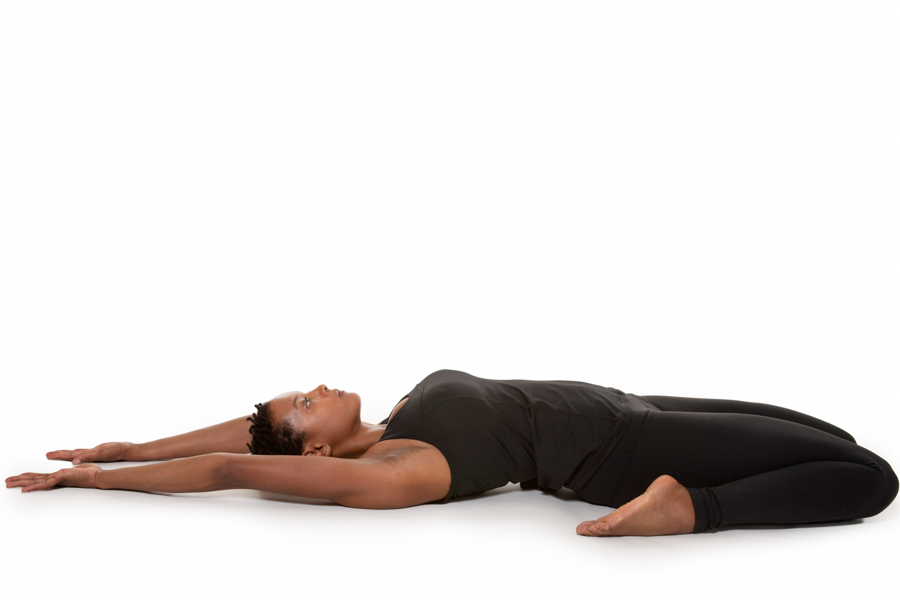 Reclining Hero begins in Hero pose and continues until the upper back and shoulders lie flat against the floor. Although Reclining Hero has the same level of difficulty as Hero pose, you may find it more challenging depending on the physical condition and flexibility of your knees, legs, back and shoulders. If reclining hero is too intense for you, practice the gently variation as you increase your flexibility. Remember to always listen to your body and do not overextend yourself.
Reclining Hero begins in Hero pose and continues until the upper back and shoulders lie flat against the floor. Although Reclining Hero has the same level of difficulty as Hero pose, you may find it more challenging depending on the physical condition and flexibility of your knees, legs, back and shoulders. If reclining hero is too intense for you, practice the gently variation as you increase your flexibility. Remember to always listen to your body and do not overextend yourself.
English Name: Reclining Hero
Sanskrit Name: Supra Virasana
Difficulty Level: 4
Start Position: Hero
Instructions:
Step 1.
Starting in hero pose, use your arms and walk your elbows back until your shoulders and head are on the floor.
Step 2.
Extend your arm up and over your head.
Step 3.
Breath normally and remaining the pose as long as it feels comfortable. To get out of the pose, you can return to hero pose or swing your feet out and roll over onto your side to come up into a sitting position.
Gentle Variation
If you feel tension in your legs, hips, low back or neck try supported hero pose reclining on a bolster or folded blanket.
Physical Benefits:
- Opens lower back & chest
- Improves lung function
- Improves knee, hip and ankle flexibility
- Helps relieve menstrual discomfort
- Can lower high blood pressure
Mental Benefits
- Reduces anxiety and stress
- Improves focus
Contraindications:
- Injured coccyx
- Knee or ankle injury (try gentle variation)
- Arthritis (try gentle variation)
- Pregnancy after 1st trimester
Virasana vs. Vajrasana
Common comments for the Virasana YouTube video is that the pose is Vajrasana or “what’s the difference between Virasana and Vajrasana.
All pose names in Hatha Yoga Asanas are based on B.K.S. Iyengar’s Light on Yoga. Other schools of yoga can call the pose by different names.
In this case, Virasana is Hero Pose and Vajrasana is kneeling pose.
provider: youtube
url: https://www.youtube.com/watch?v=Ac4z-bvplMs&start=62
src: https://www.youtube-nocookie.com/embed/Ac4z-bvplMs?start=62&feature=oembed
src mod: https://www.youtube-nocookie.com/embed/Ac4z-bvplMs?start=62
src gen: https://www.youtube-nocookie.com/embed/Ac4z-bvplMs
Staff Pose (dandasana)
- At March 10, 2020
- By Daniel
- In Asana, Yoga Benefits
 0
0
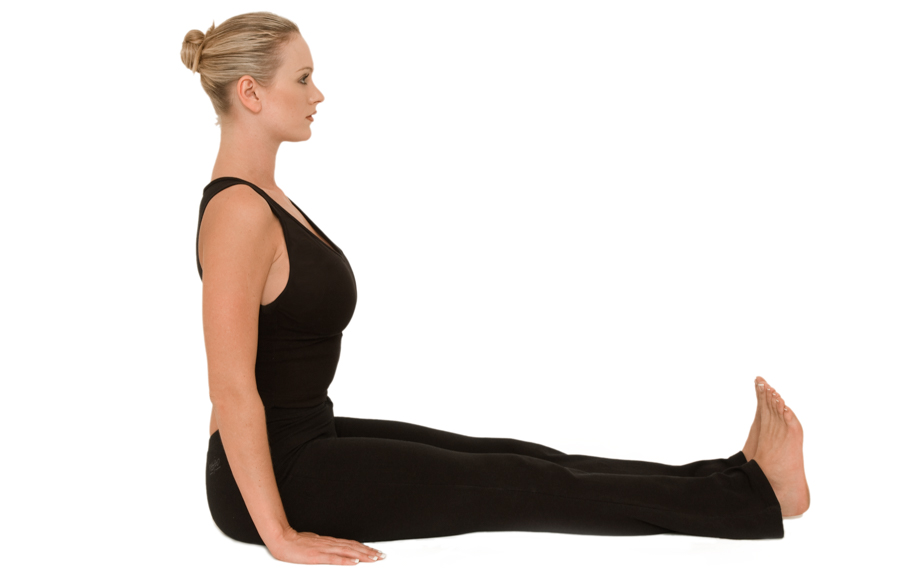 Staff is a deceptively simple looking sitting pose that works all major muscles and can reduce stress, improve circulation and concentration, and strengthen legs and arms.
Staff is a deceptively simple looking sitting pose that works all major muscles and can reduce stress, improve circulation and concentration, and strengthen legs and arms.
English Name: Staff
Sanskrit Name: Dandasana
Difficulty Level: 2
Start Position: Seated
Instructions:
Step 1.
Sit on the floor upright and extend your legs forward toes pointed towards the sky.
Step 2.
Flex your feet and engage your abdomen. Your ankles should be about one inch (2.5 cm) above the floor.
Physical Benefits:
- Tones the abdominal muscles
- Improves circulation
- Opens the chest
- Strengthens legs
- Strengthens arms
- Strengthens torso and spine
- Improves leg and spine muscular endurance
Mental Benefits
- Reduces stress
- Creates focus
Contraindications:
- Injured coccyx
Frog (bhekasana)
- At March 10, 2020
- By Daniel
- In Asana, Yoga Benefits
 0
0
 Frog pose takes Reclining Hero pose and turns it on its stomach rather than back. If you can do Reclining Hero you can do Frog. Frog adds extending your check like Cobra pose and grasping your feet with your hands. While Cobra and Reclining Hero have a difficulty level of 4, Frog increases the difficulty level to 6 giving your arms, back, and legs a good stretch.
Frog pose takes Reclining Hero pose and turns it on its stomach rather than back. If you can do Reclining Hero you can do Frog. Frog adds extending your check like Cobra pose and grasping your feet with your hands. While Cobra and Reclining Hero have a difficulty level of 4, Frog increases the difficulty level to 6 giving your arms, back, and legs a good stretch.
Like all hatha yoga asanas, always listen to you body to prevent injuries.
English Name: Frog
Sanskrit Name: Bhekasana
Difficulty Level: 6
Start Position: Lying On Belly
Instructions:
Step 1.
Bend one leg at a time next to your hips and grasp your toes with you hands.
Step 2.
Extend your chest forward and upward.
Step 3.
Hold the pose for 4 or 5 breathes, or as long as it feels comfortable.
Step 4.
Release and return to lying on your belly.
Physical Benefits:
- Stretches leg, arm, and back muscles
- Opens up the chest
- Improves lung capacity
- Improves digestions
- Increase leg and arm flexibility
Mental Benefits
- Reduces stress
- Improves thinking
- Increases focus
- Relieves mild anxiety & depression
Contraindications:
- Arm, back, or leg injury
- Wrist or neck injury
- Carpel tunnel syndrome
Easy Sitting (Sukhasana)
- At March 10, 2020
- By Daniel
- In Asana, Yoga Benefits
 0
0
 Easy sitting looks like a very simple pose. But, many people are not flexible enough to have both knees contacting the floor. If you are one of them, it is not a problem. Unlike other physical activities, yoga is not about no pain – no gain. Pain is your bodies way of telling you you have over extended yourself.
Easy sitting looks like a very simple pose. But, many people are not flexible enough to have both knees contacting the floor. If you are one of them, it is not a problem. Unlike other physical activities, yoga is not about no pain – no gain. Pain is your bodies way of telling you you have over extended yourself.
Yoga is not about pain, it is about peace, tranquility, and transcending to a higher level of consciousness. For many Americans, this aspect of yoga is ignored or forgotten.
While easy sitting may not be as easy as shown and described, your flexibility will increase with practice.
Easy sitting is another meditation pose like Lotus and Looking Within.
While it looks deceptively simple, easy sitting has many physical and mental benefits.
English Name: Easy Sitting
Sanskrit Name: Sukhasana
Difficulty Level: 1
Start Position: Staff
Instructions:
Step 1.
While sitting in Staff pose, bend your right foot forwards your body, rotating your right hip so your right knee rests on the floor.
Step 2.
Bend your left knee and align your left foot in from of your right ankle. Rest your hands on your knees with the palms up or down.
Kneeling Pose (Vajrasana or bhujrasana)
- At March 10, 2020
- By Daniel
- In Asana, Yoga Benefits
 0
0
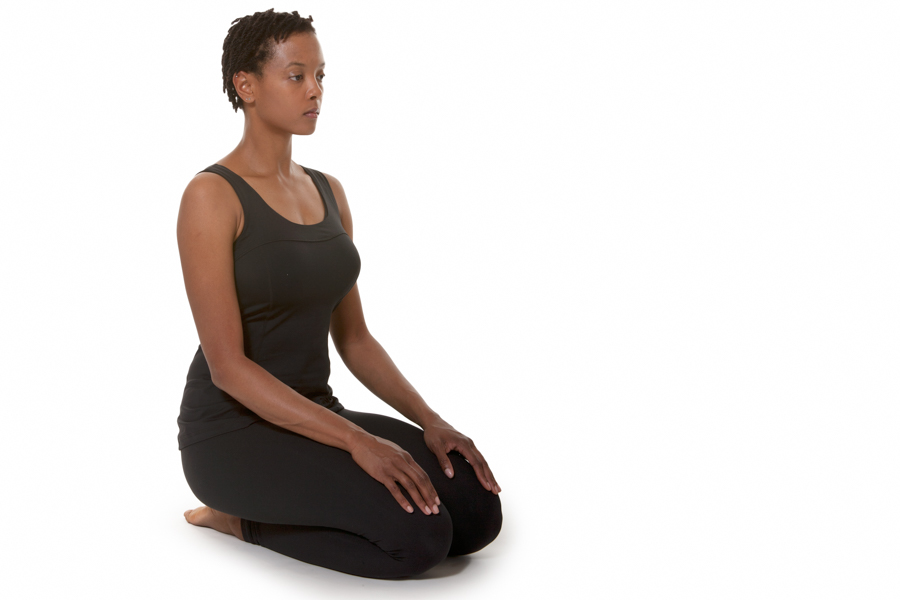 Kneeling Pose, is a deceptively simple looking pose, but it can help calm the mind and is the start position for Camel and Cow Face poses. If you have knee or ankle problems, try Easy Sitting instead.
Kneeling Pose, is a deceptively simple looking pose, but it can help calm the mind and is the start position for Camel and Cow Face poses. If you have knee or ankle problems, try Easy Sitting instead.
English Name: Kneeling
Sanskrit Name: Vajrasana or Bhujrasana
Difficulty Level: 1
Start Position: Kneeling
Instructions:
Step 1.
While kneeling lower yourself down until you are sitting on both heels
Step 2.
Keep your back straight and rest both hands on your knees.
Step 3.
Remain in the pose as long as it feels comfortable.
Physical Benefits:
- Aligns spine
- Improves circulation
- Invigorates hips, calves and ankles
- Opens knee, ankle, and hip joints
- Stretches quadricep muscles
Mental Benefits
- Calms the mind
Contraindications:
- Knee injury
- Ankle injury

